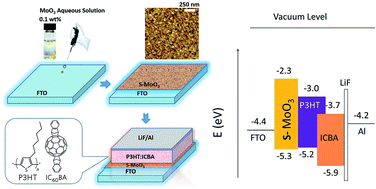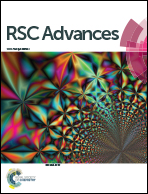Enhancing the performance and stability of organic solar cells using solution processed MoO3 as hole transport layer
Abstract
Efficient and stable poly(3-hexylthiophene) (P3HT):indene-C60 bisadduct (ICBA) based bulk-heterojunction (BHJ) organic solar cells (OSCs) with solution processed MoO3 (s-MoO3) as hole transport layer were fabricated. We used a facile and cost-effective preparation method to obtain a MoO3 aqueous solution by thermal decomposition of (NH4)6Mo7O24·4H2O. The s-MoO3 ultra-thin film was treated in three different ways to compare the effects of the annealing mode: no annealing, 100 °C thermal annealing and ultraviolet (UV) annealing. The transmittance, surface morphology and film quality of the s-MoO3 film can be enhanced by UV annealing treatment, which is favorable to the performance of devices. The OSCs with UV annealing treated s-MoO3 as the hole transport layer exhibit a good power conversion efficiency (PCE) of 5.4% and better stability.



 Please wait while we load your content...
Please wait while we load your content...